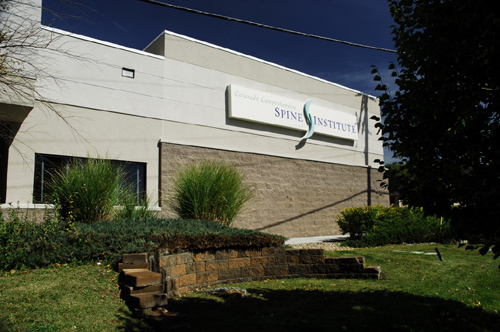Locations

Fax: (303) 762-9292

Exercise for a Healthy Spine
We have all heard how exercise is good for the heart, improves circulation, and helps people lose weight. But did you know that regular exercise is also good for your spine? Not only will exercise improve your overall fitness, research shows that it can also help prevent back injuries and reduce back pain.
But in the wide world of fitness and exercise, how do you know which exercises are best for you? Keep the following in mind.
Types of Exercise
There are 3 basic types of exercise:
- Strengthening - helps increase muscle tone and endurance
- Stretching - increases flexibility and allows for full, normal movement
- Aerobic - strengthens the heart and lungs and improves circulation
Strengthening Exercise
Strengthening your muscles, especially the abdominal and back muscles, will help stabilize the spine and make it easier to maintain correct posture and perform daily activities. Strong muscles will help support and protect your joints and help prevent injury to the connective tissue found in the knees, neck, shoulders, elbows, ankles and, most importantly, the lower back.
There are many ways to do strengthening exercises. You can use free weights, exercise machines, elastic bands, even water exercises. However, don't feel you need to buy expensive equipment or join exclusive fitness centers to be able to do this type of exercise. The following are just a few examples of strengthening exercises that can be done at home and do not require expensive equipment.
For low back strength and stability:
- Pelvic Tilt
- Lie on your back with your knees bent and feet flat on the floor.
- Tighten your abdominal muscles.
- Tilt your pelvic bone up while pressing your lower back toward the floor.
- Visualize "pulling" your navel through your abdomen towards the floor.
- Hold for 3-5 seconds, then relax.
- Do 10-20 repetitions.
- Abdominal Curl
- Lie on your back with your knees bent and feet flat on the floor.
- Tighten your abdominal muscles. o In one slow but continuous movement, curl your chin toward your chest and roll upward until your shoulder blades are off the floor.
- Notice that this is NOT a full "sit up."
- No Range of Motion of the low back is desired.
- Hold for 3-5 seconds, then slowly lower.
- Do 10-20 repetitions.
- Leg Lift
- Lie flat on your back.
- Pull your toes up towards your nose
- Lift one leg only while you stabilize the pelvis with the other.
- Hold for 3-5 seconds, then slowly lower
- Repeat with the other leg, one at a time.
- Do 10-20 repetitions.
For upper body strength and Stability:
- Shoulder Shrugs
- Stand on the floor with your feet shoulder-width apart.
- Keeping your head straight, slowly raise your shoulders up toward your ears.
- Hold for 3-5 seconds.
- Then press your shoulders down as far as possible and hold for 3-5 seconds.
- Do 10-20 repetitions.
- Bent-Over Rowing
- Stand on the floor with your feet shoulder-width apart and knees slightly bent.
- Keeping the normal curves in the back, bend at your waist to about 70 degrees.
- Let your arms dangle straight down.
- Using light weights in each hand, slowly raise your elbows up until they are level with the shoulders and bent 90 degrees. Make sure your elbows are straight out from your shoulders.
- Do 10-20 repetitions.
When performing strengthening exercises, keep the following in mind:
- Strengthening exercises should be done 3-4 days a week.
- Perform these exercises slowly and smoothly; avoid sudden or jerking movements.
- Do not hold your breath during exercise. Exhale on the exertion.
- If you experience any pain, stop exercising immediately.
Stretching Exercise
This type of exercise helps to improve and maintain flexibility, so you can move your arms, legs, neck, and back through their full range of motion. Stretching also helps prevent muscle strain and soreness and helps prepare your body for more strenuous activity. Stretching exercises therefore should be done before and after any type of vigorous workout.
A few examples of stretching exercises include the following:
- Hamstring Stretch
- Lie flat on your back and gently press your hips to the ground.
- Bend your left leg slightly.
- Keeping your toes relaxed, raise your right leg straight up as far as it is comfortable.
- Place your arm below your raised knee for added support if needed.
- Hold for 10 seconds, do not bounce.
- Switch legs and repeat.
- Abdominal Stretch
- Lie flat on your stomach.
- Lift your upper body, rest your weight on your elbows and raise your chin slightly.
- Hold for 10 seconds, do not bounce
- Lower Back Stretch:
- Lie flat on your back and gently press your hips to the ground.
- Raise your right let and gently pull your knee toward your chest.
- Hold for 10 seconds, do not bounce.
- Gently lower the leg all the way flat.
- Switch legs and repeat.
When performing stretching exercises, keep the following in mind:
- Stretching exercises should be done daily.
- Stretch as far as you can - but not to the point of pain - then release.
- Perform these exercises slowly and smoothly; avoid sudden or jerking movements.
- Do not bounce when stretching, you can injure or strain your muscles that way.
- If you experience any pain, stop exercising immediately.
Aerobic Exercise
Aerobic exercise has numerous benefits including strengthening the heart and lungs, increasing energy, improving sleep, decreasing blood pressure, and burning calories for weight loss.
If you are athletic, there are plenty of sports activities that are aerobic in nature including jogging, biking, swimming, walking, cross-country skiing, and skating. But even if you are not an athlete, there are ways to incorporate aerobic activities into your daily life. Here are a few examples:
- Use the stairs instead of the elevator at work
- If possible, walk instead of drive to a store or restaurant.
- Park your car farther away from a store or the office so you can walk.
- Find a friend to walk, skate, or bike with.
Try to incorporate at least 15 minutes of any type of aerobic activity 3-4 times a week. Each session should begin with a few minutes of warm-up stretching and end with at a few minutes of cool-down stretching. This will help you avoid injury and decrease soreness and muscle fatigue.
A few good examples of low impact, aerobic exercises include swimming laps, cycling, spinning, or treadmill walking at slow speed.
Keep in mind, if you have not exercised in a long while, have any type of medical condition, or are not sure how to begin, talk to your primary care physician or one of our spine specialists here at CCSI. Never start any new exercise regimen without seeing your doctor first.
Keeping Healthy
As you can see, exercise need not be difficult to be effective. It's never too late to begin a fitness routine that can help improve your health and well-being. At CCSI, we care about all aspects of your health and are happy to discuss fitness issues if you need help. Simply call our office to talk to one of our spine specialists today.








